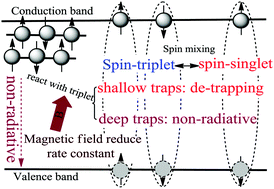Exploring the role of spin-triplets and trap states in photovoltaic processes of perovskite solar cells†
Abstract
The efficiency of perovskite solar cells is critically affected by the charge traps in the perovskite layer. Herein, we studied the recombination and dissociation processes of photo-excited states in perovskite solar cells with different densities and depths of the trap states in the perovskite layer using magneto-photocurrent measurements. The devices with lower density of traps show higher power conversion efficiency and negative magneto-photocurrent, whereas devices with higher density of deep traps exhibit lower power conversion efficiency and positive magneto-photocurrent. As the strong spin orbital coupling is induced by heavy atoms (Pb, I) in the perovskite materials, the original photo-excited spin-singlets (φml=±1φ↑e↓h) will transform into spin-triplets (φml=0φ↑e↑h) through intersystem crossing. In particular, the spin-triplets and trap states play an important role in photovoltaic actions of perovskite solar cells. Depending upon the depth of the traps, the spin-triplets can de-trap shallow charge carrier traps and subsequently contribute to the photocurrent in the perovskite solar cell, while the spin-triplets will be destroyed with the deep charge carrier traps, giving rise to non-radiative recombination in the perovskite solar cell. Our study elucidates the underlying mechanism, by which the spin configuration of photo-excited states, trap density and depth of traps impact the recombination and dissociation processes of the photo-excited states in perovskite solar cells based on the CH3NH3PbI3(Cl) system.



 Please wait while we load your content...
Please wait while we load your content...